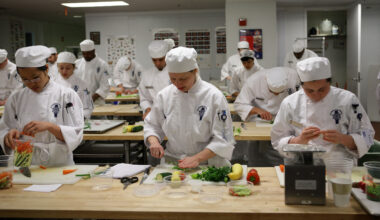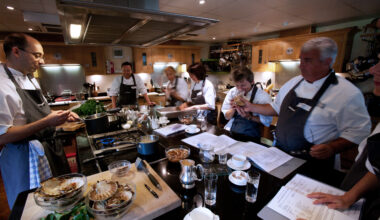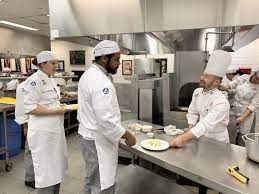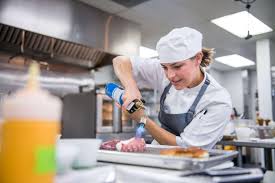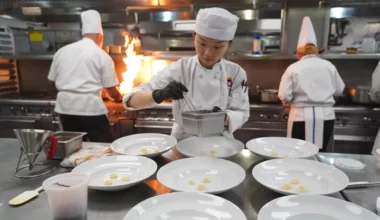With the growing interest in culinary careers, aspiring chefs are faced with the decision between attending culinary school or pursuing an apprenticeship. Both paths offer unique opportunities to develop the necessary skills and knowledge for a successful culinary career.
In this article, we will explore the benefits and considerations of each option, helping you make an informed decision about your culinary journey.
Table of Contents
What is Culinary School?
Culinary schools are institutions that provide comprehensive culinary education to students. These schools offer a structured curriculum with a focus on culinary techniques, kitchen management, and theoretical knowledge.
The Benefits of Attending Culinary School
Comprehensive culinary education: Culinary schools offer a well-rounded education that covers various aspects of the culinary industry, including cooking techniques, menu planning, and food safety.
Exposure to various cuisines: Culinary schools often expose students to a wide range of cuisines, allowing them to develop a diverse culinary repertoire and an understanding of global flavors.
Professional networking opportunities: Culinary schools often provide students with opportunities to connect with industry professionals, such as guest chefs and alumni, which can lead to valuable connections and job opportunities.
Read Also: 8 Best Cooking Schools in San Francisco | How to Apply
What is an Apprenticeship?
An apprenticeship is a hands-on training program where aspiring chefs work under the guidance of experienced professionals. This option allows individuals to learn the practical skills required in a professional kitchen while gaining real-world exposure to industry practices.
The Advantages of Choosing an Apprenticeship
- Hands-on experience: Apprenticeships provide aspiring chefs with extensive hands-on experience, allowing them to develop crucial culinary skills through practical application.
- Mentorship and guidance from experienced chefs: Working alongside seasoned professionals enables apprentices to learn from their expertise, receive valuable feedback, and gain insights into the culinary industry.
- Real-world exposure to industry practices: Apprenticeships offer a unique opportunity to experience the realities of a professional kitchen, from fast-paced environments to demanding physical exertion.
Criteria for Choosing the Right Path
When deciding between culinary school and apprenticeships, it’s crucial to consider personal preferences and learning styles.
- Interactive and hands-on learners: If you thrive in hands-on environments and learn best through practical application, an apprenticeship may be the ideal choice for you. The immersive nature of apprenticeships allows for immediate engagement and skill development.
- Structured and academic learners: For those who prefer a more structured and academic approach to learning, culinary school provides a comprehensive curriculum that covers theoretical knowledge and practical training.
- Assessing financial considerations: Consider your financial situation when weighing the options. Culinary schools often require tuition fees and additional expenses, while apprenticeships offer the potential for earning wages during training.
Read Also: 7 Best Culinary Schools in China | How to Apply
Comparing Curriculum and Training
Culinary school curriculum
- Culinary school curricula consist of a wide range of courses tailored to provide students with a strong foundation in culinary arts. These courses cover topics such as nutrition, culinary techniques, pastry arts, and menu planning.
- Courses and specialization options: Culinary schools offer various courses, allowing students to specialize in specific culinary areas, such as baking and pastry, international cuisine, or culinary management.
- Practical training in professional kitchens: Culinary schools provide students with hands-on training in well-equipped professional kitchens, allowing them to practice and refine their skills in a controlled environment.
Apprenticeship training
- Apprenticeships focus on practical, on-the-job training, where apprentices work in real kitchens alongside experienced chefs. This training method emphasizes adaptability and exposure to diverse culinary environments.
- Rotational learning in different kitchen areas: Apprenticeships often include rotations within different kitchen stations, providing a comprehensive understanding of various culinary techniques and responsibilities.
- Adaptability and exposure to diverse culinary environments: Apprenticeships expose individuals to different types of culinary establishments, from high-end restaurants to catering services, fostering adaptability and versatility.
Duration and Time Commitment
Length of culinary school programs
The duration of culinary school programs can vary, ranging from a few months to several years. Associate degrees typically take around two years to complete, while baccalaureate degrees can take up to four years.
Accelerated programs and certificate options: Culinary schools may also offer accelerated programs and certificate options for individuals looking for a shorter time commitment.
Apprenticeship duration
The length of apprenticeships varies across regions and establishments. Some apprenticeships last for a few weeks, while others can span several years.
Varying apprenticeship lengths across regions: The duration of apprenticeships depends on regional guidelines and the specific training program.
Balancing work hours and personal life: Apprenticeships often require long work hours, including evenings and weekends. It’s essential to consider the impact on personal life and commitments.
Cost Analysis
Culinary School Expenses
Attending culinary school may involve various expenses beyond tuition fees.
- Tuition fees and books: Culinary schools require tuition payments, and additional expenses can include textbooks and class materials.
- Additional equipment and uniform costs: Students may need to purchase culinary tools, uniforms, and other equipment necessary for their studies.
Financial considerations in apprenticeships
While apprenticeships generally do not require tuition fees, financial considerations are still important to assess.
- Potential wages and compensation: Apprenticeships often provide wages or stipends, allowing apprentices to earn while they learn.
- Managing living expenses during apprenticeships: It’s essential to consider the cost of living during an apprenticeship, especially if relocation or travel is required.
Read Also: Best Culinary Schools in Germany
Career Prospects and Job Market
Job opportunities after culinary school graduation
Culinary school provides graduates with a range of entry-level positions in the culinary industry.
- Entry-level positions and industry demands: Graduates can pursue opportunities as line cooks, prep chefs, or pastry chefs in restaurants, hotels, catering companies, and other culinary establishments.
- Advancement within the culinary world: As aspiring chefs gain experience and exhibit their skills, they can progress to higher positions, such as sous chefs, executive chefs, or even restaurant owners.
Career prospects for apprentices
Apprenticeships offer the advantage of establishing connections within the industry.
- Creating connections and securing job offers: Apprenticeships provide opportunities to network with professionals, potentially leading to job offers or long-term employment.
- Advantages of professional experience over educational credentials: Many employers in the culinary industry value practical experience gained through apprenticeships, sometimes considering it more important than formal education.
Networking and Industry Connections
Culinary school networking opportunities
Culinary schools often facilitate networking through various avenues.
- Building relationships with instructors and alumni: Students can forge relationships with experienced instructors and fellow students, creating a network of industry professionals.
- Internship and externship placements: Culinary schools often help students secure internships or externships at reputable establishments, enhancing networking opportunities.
Building connections through apprenticeships
Apprenticeships provide firsthand exposure to industry professionals.
- Networking with experienced professionals: Working alongside seasoned chefs and industry professionals allows apprentices to establish connections that can lead to future job opportunities.
- Establishing a strong reputation within the industry: A successful apprenticeship can contribute to an apprentice’s reputation and professional network, opening doors to future prospects.
Read Also: Best Culinary Schools in Florida
Flexibility and Transferable Skills
Transferable skills from culinary school
Culinary school graduates develop skills beyond cooking techniques.
- Business and management knowledge: Culinary school education often includes courses in kitchen management, menu planning, and food cost control, equipping graduates with business and management skills.
- Adaptability to different kitchen environments: Through exposure to various cuisines and culinary styles, culinary school graduates gain practical experience that enables them to adapt to diverse kitchen environments.
Flexibility gained through apprenticeships
Apprenticeships cultivate flexibility and adaptability in culinary professionals.
- Ability to work in various locations and settings: Apprenticeships expose individuals to different kitchen environments, preparing them to work in a variety of establishments and adapt to changing circumstances.
- Developing a range of culinary skills: Apprentices may have the opportunity to learn from chefs specializing in different cuisines, broadening their culinary skill set.
Cultural and Global Exposure
Culinary school’s focus on international cuisines
Culinary schools often highlight global culinary traditions.
Exploring diverse culinary traditions: Culinary school education exposes students to a variety of international cuisines, fostering cultural awareness and appreciation.
Gaining cultural awareness through food: Students learn about the cultural significance of different dishes, ingredients, and culinary customs, promoting a deeper understanding of global diversity.
Exposure to global culinary influences during apprenticeships
Apprenticeships allow individuals to learn from chefs with diverse backgrounds.
- Learning from chefs with different backgrounds: By working with experienced chefs from various cultural backgrounds, apprentices can learn new techniques, flavors, and approaches to cooking.
- Incorporating international techniques and flavors: Apprenticeships provide the opportunity to incorporate international culinary influences into one’s repertoire, enhancing creativity and adaptability.
Read Also: Best Culinary Schools in Utah | Ranking
Practical Considerations
Work-Life balance in culinary school
Managing time and personal commitments is crucial in culinary school.
- Balancing coursework and personal life: Culinary school can be demanding, requiring students to juggle assignments, exams, and practical projects while maintaining a healthy work-life balance.
- Managing practical assignments and projects: Culinary school often involves hands-on projects and assignments that require dedication and time management skills.
Apprenticeship demands and work ethics
Apprenticeships require commitment and dedication to continuous learning.
- Long hours and physical demands: Apprenticeships can be physically demanding and involve long hours, including evenings and weekends. A strong work ethic is necessary to thrive in this environment.
- Commitment to continuous learning and improvement: Apprenticeships emphasize the importance of continuous learning, fine-tuning culinary skills, and adapting to new kitchen environments.
Opportunities for Innovation and Creativity
Encouraging innovation in culinary schools
Culinary schools foster creativity through various initiatives.
- Experimental techniques and cutting-edge ideas: Culinary schools often encourage students to experiment with innovative cooking techniques and explore new culinary trends.
- Collaborative projects and culinary competitions: Students may participate in collaborative projects or culinary competitions, challenging their creativity and providing opportunities for recognition.
Cultivating creativity through apprenticeships
Apprenticeships offer a hands-on environment for developing culinary creativity.
- Adapting recipes and techniques under mentorship: Apprentices work closely with experienced chefs, allowing for creative adaptations of recipes and techniques, fostering personal culinary identities.
- Incorporating personal culinary identities: Apprenticeships provide a platform for apprentices to express their unique culinary visions and incorporate personal styles and flavors into their cooking.
Return on Investment (ROI)
Assessing ROI from Culinary School
It’s essential to evaluate the potential return on investment in culinary school.
- Post-graduation job prospects and income potential: Culinary school graduates can expect entry-level positions that may offer competitive starting salaries.
- Long-term career growth and advancement: Formal culinary education can provide a strong foundation for career growth and advancement into higher-paying positions within the culinary industry.
Evaluating ROI from apprenticeships
Apprenticeships offer immediate hands-on experience that can impact future career prospects.
- Value of immediate hands-on experience: Apprentices gain practical skills quickly, potentially leading to faster career progression and increased earning potential.
- Earning potential and job opportunities: Demonstrating proficiency and professional growth during an apprenticeship can open doors to job offers and higher-paying culinary positions.
Read Also: 10 Best Culinary Schools in Los Angeles | How to Apply
The Case for Combining Both Paths
Some individuals opt to pursue both culinary school and apprenticeships simultaneously.
- Complementing theoretical knowledge with practical skills: Combining formal culinary education with hands-on experience provides a well-rounded culinary foundation.
- Gaining a competitive edge in the industry: A combination of culinary school education and apprenticeships can make aspiring chefs more marketable and competitive in the culinary job market.
- Balancing time and financial commitments: Hybrid programs that offer part-time apprenticeships while attending culinary school allow individuals to manage time and financial obligations effectively.
FAQs
Here are some frequently asked questions regarding culinary school and apprenticeships:
Can I start an apprenticeship without any culinary background or education?
Yes, apprenticeships are often open to individuals without prior culinary education or experience. They provide an opportunity to learn alongside experienced professionals and gain practical skills.
Will attending a prestigious culinary school guarantee a successful career?
Attending a prestigious culinary school can certainly provide a strong foundation for a culinary career. However, success in the culinary industry is also dependent on factors such as skills, determination, networking, and continuous learning.
Are apprenticeships only available in high-end restaurants?
No, apprenticeships are available in a variety of culinary establishments, ranging from high-end restaurants to catering services, hotels, and even cafeterias. The opportunities for apprenticeships exist across different segments of the culinary industry.
Can I switch from culinary school to an apprenticeship, or vice versa?
It is possible to switch from culinary school to an apprenticeship or vice versa, depending on personal circumstances and the availability of opportunities. Each path provides unique experiences and advantages, and individuals can explore different options based on their goals and interests.
Conclusion
Choosing the right path for your culinary career is a decision that requires careful consideration. By evaluating personal preferences, learning styles, financial considerations, and long-term goals, aspiring chefs can make an informed choice between culinary school and apprenticeships.
Whether you choose to pursue a formal education or opt for hands-on training, both paths offer unique advantages that can help lay the foundation for a successful culinary career. Remember, the key to success lies in passion, dedication, and continuous growth within the culinary industry.
